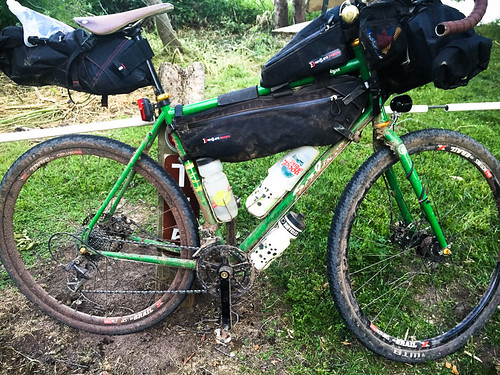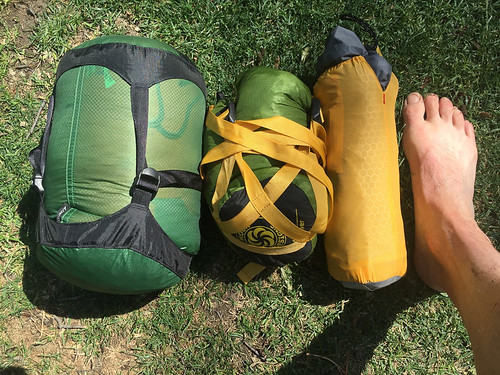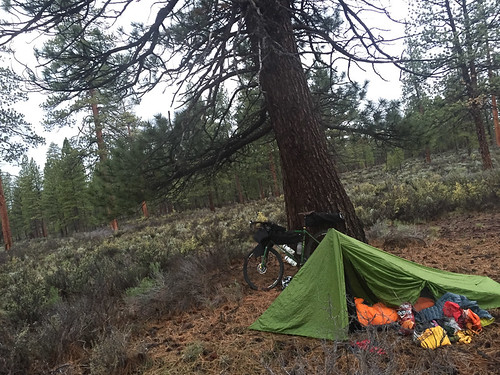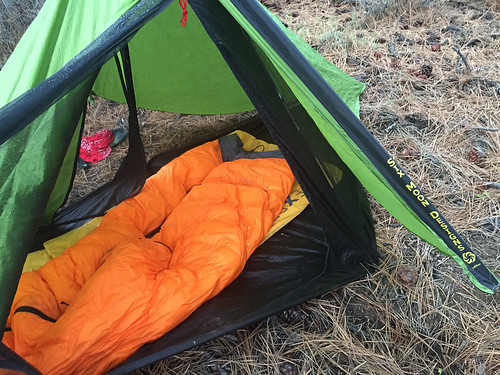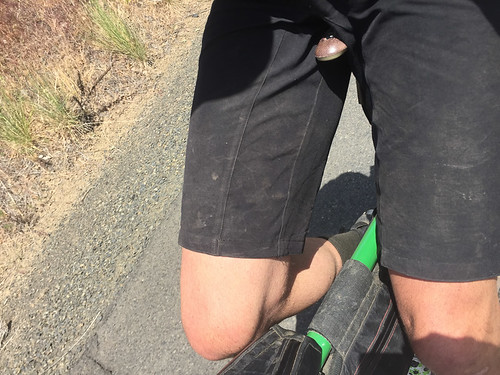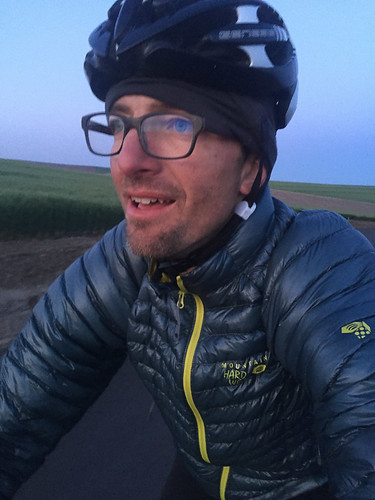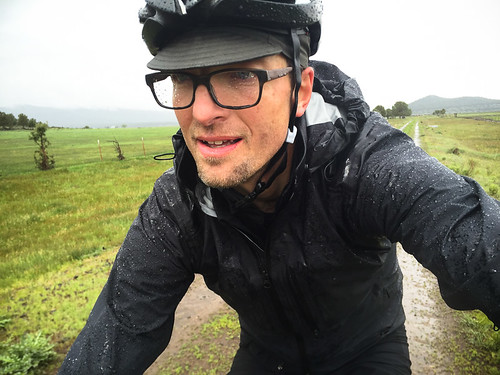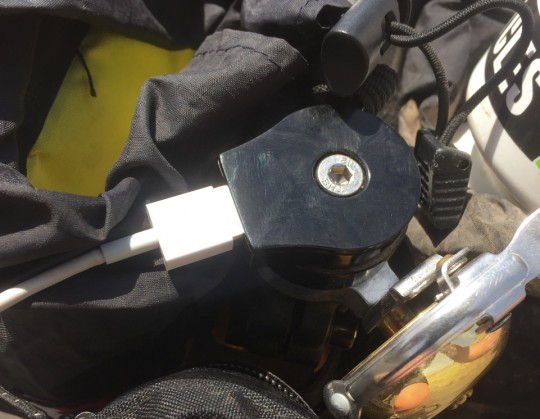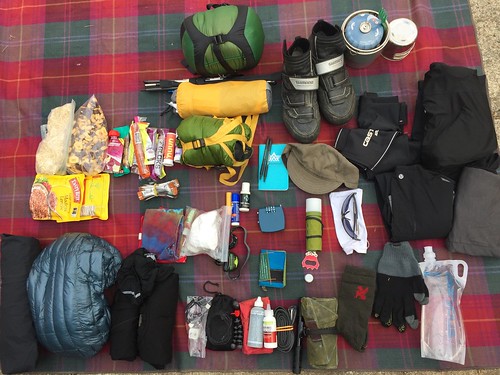
(Photos © J. Maus/BikePortland)
I had no idea what to expect before riding 505 miles in three days on the Oregon Outback last month. What I did know is that whatever happened, I’d count on my gear to help get me through it.
I also knew that if the ride wasn’t destined to go well, I hoped it’d be due to things (mostly) out of my control — like mechanical or physical mishaps, crazy weather, route problems, and so on. Thank goodness I was lucky. Pretty much everything went smoothly. I was also very fortunate to have used excellent gear that I can now confidently recommend if you are headed out on an adventure of your own.
Below are a few photos and my thoughts on the gear that helped get me through the Outback — from the first mile to the last — with a smile on my face…
Bikes have always been a motivator for me. When I was 18 (in 1993) I bought a GT Zaskar. It had XT components and was nearly $2,000 (a lot of money, especially for an teenager). It was a racing bike and I figured I would be a poser if I didn’t actually race on it. So I did. And it changed my life.
Fast forward 22 years and another bike had a similar effect. Once I got a bike set up specifically for adventure riding and bikepacking, there was no turning back. There were be no more excuses for not getting out there and trying big rides like the Outback.
Here in Portland we’re lucky to live in one of the healthiest bikepacking ecosystems anywhere. Part of that ecosystem is the growing number of shops with real expertise in setting bikes up for adventure. 21st Avenue Bicycles is one of them. I had been an admirer of their custom builds for a while and heard the buzz that they were bikepacking-friendly. Turns out it was all true and they’re a great shop to work with. They listened to what I needed and set me up with one of the most versatile, dependable, tried-and-true adventure bikes on the market: the Vaya by Salsa Cycles.
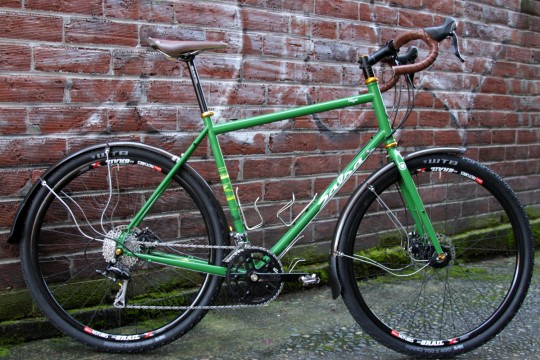
(Photo by 21st Avenue Bicycles)
The Vaya they built up for me is far from stock. Shop manager Nick Wood and his crew put together an intelligent build that includes: Shimano 2×10 drivetrain with 105 shifters and derailleurs; White Industries VBC crankset; Stan’s Grail tubeless rims with WTB Nano 40c tires; XT rear hub and Alfine 501 dynamo front hub; Chris King headset (with matching gold seat collar and skewers from Salsa); Jagwire sealed shifter/cable housing; King Cage bottle cages; Brooks Cambium saddle; Avid BB7 brakes; and Salsa Cowbell bar/stem.
On the road or off it, the bike rides great. It’s one of the most comfortable bikes I’ve ever owned. I can (and did!) ride it all day and night. The wide bars give me plenty of hand position choices and the the 40c tires give me a lot of confidence on the rocks and downhills (maybe too much confidence, since I’ve already flatted both tires after hitting rocks at high speeds). My favorite thing about the bike is that it can handle rough roads but it doesn’t sacrifice too much on the pavement. My riding is usually 50-50 pavement-gravel/dirt and the Vaya behaves equally well in both environments. Follow along on all our adventures together here. — Salsa Cycles Vaya
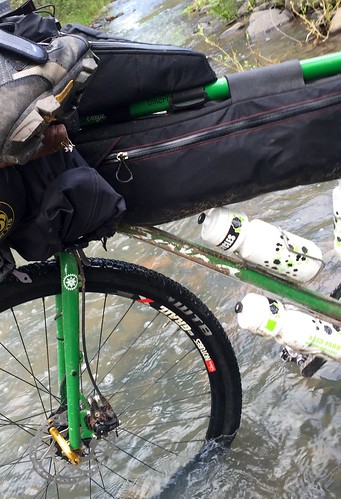
unseasonably high stream in the Ochoco National Forest.
I’ve always been a rack-and-pannier guy and I’m new to the frame-bag thing. Now I’m kicking myself for not getting these sooner. Revelate bags are so efficient: They set up tight to the bike and carry a surprising amount of stuff.
You know how some people say you can judge the quality of a car by slamming a door and listening to the sound it makes? When I yank on the zipper of these Revelate bags, they just sound well-made. They’re tough (fabric is thick in all the right places), waterproof, and have all the little built-in features that make life on the road easier. What I really like are all the cinch straps and buckles that allow me to keep them snug (I abhor floppiness).
I have a special place in my heart for the Feedbag. I used one of these on each side of my stem: one for my phone (which was also my camera/GPS device/route map so it needed to be easily accessible) and small food items, the other for a water bottle. — RevelateDesigns.com
Lightweight sleeping gear is a must if you want to make lots of miles in the backcountry. My one night of real slumber on the Outback was crucial because it prepared me for two days where I rode 365 miles and tallied about 23,000 feet of climbing.
To get the right gear I turned to Mountain Shop in the Hollywood neighborhood. Not only are they the oldest outdoor shop in Portland but they are committed to bikepacking: They have an entire studio devoted to sales and rentals of adventure bikes. When I told store manager Guy Trombley what I needed (and that I was a novice on the topic), he took me through everything and had spot-on recommendations…
Exped Synmat UL 7 sleeping mat ($149)
This mat is comfortable, light, it packs small, and it’s super easy to inflate and deflate. What else is there to say? — Exped
Flicker 20 UL Quilt Bag – Feathered Friends ($359)
Feathered Friends is a small, Seattle-based company known for its high-quality down sleeping bags. The model I used, the Flicker, is actually a quilt that opens up flat so I can use it as a blanket or a bag. The 900+ goose down has excellent loft and warmth that compresses down to about 7 x 10 inches and it weighs just under two pounds. The zipper is top-notch and I loved the cinches at the top that allowed me to snuggle in when it got chilly. — Feathered Friends
Advertisement
Skyscape Trekker tent by Six Moon Designs 24 oz ($235)
Six Moon Designs is a Beaverton-based company (!) that was recommended to me by the staff at Mountain Shop. I was initially interested in their single-pole Lunar Solo model, but opted for the Skyscape Trekker because it weighs the same and has more features. At just 24 ounces, this tent packs a lot of function into a small package. I love that it has two entry doors (so I don’t have to crawl over all my stuff to get out) and I found it very straightforward to put up. I sealed the seams, so the silicon nylon outer shell did just fine with a bit of overnight drizzle and rain. — Six Moon Designs
Rapha Touring Shorts ($125)
My friend at Rapha calls these his “modesty shorts.” I get the modesty thing, but I also prefer to wear shorts over my tight spandex because it helps me look more like a normal person when I’m out in the country. These shorts worked perfectly. They’re snug fitting (like all Rapha stuff) and have a minimalist design. If you want big pockets, look elsewhere. These shorts have just two, small (zippered) pockets — one in front and one in back. Smooth and silky fabric on the leg cuffs allowed the shorts to roll over my thighs without chafing or rubbing. — Rapha
Mountain Hardwear Ghost Whisperer Jacket ($320)
I was probably one of the last Portland bike enthusiasts without a down jacket. It just seemed like such an extravagance! I finally caved because for bikepacking it’s really hard to beat the warmth and packability of down. The Ghost Whisperer weighs just 7 ounces. I didn’t pack a long-sleeve shirt, baselayer or sweatshirt, so this jacket really came in handy while riding in cool moonlit air in the wee hours of the morning. — Mountain Hardwear
Acre Meridian Waterproof Jacket ($455)
This is the best performing — and best looking — rain jacket I’ve ever owned (it’s also the most expensive). With the unexpected amount of rain we got, I was very fortunate to have this along for the ride. Acre (a division of Mission Workshop) has really raised the bar. The cut is snug without being restrictive. The Polartec NeoShell fabric stretches ever so slightly and somehow it’s breathable and waterproof (I know, that isn’t supposed to be possible). I rode about 100 miles in the rain with this thing on and when it was really pouring, I pulled the hood over my helmet. Then, when I didn’t need the hood, I just reached around and unsnapped it without even getting off my bike. The zips in the sleeves are in just the right spot where I could open or close them with one hand. The one odd thing about this jacket are the front pockets. They’re there, but not really large enough to fit your hands in.
What really impresses me about this jacket is that I can wear it with confidence in the demanding conditions of the Oregon Outback, and I can also wear it to work with a nice pair of pants. — Acre Supply
Cliff Shot Bloks ($2 per pack)
I’m not one for high-tech food but these little “energy chews” were one of my go-to sources for on-the-bike nourishment (along with trail mix). I have had muscle cramping issues throughout my years of riding, but I didn’t cramp up once on the Outback. Whether related or not, I now swear by Shot Bloks. They’re easy to eat, taste great (better than Gummi Bears!), and have caffeine, potassium, and electrolytes. — Clif Bar
Outdoor Tech Buckshot All-in-One Wireless Speaker/Power Bank/Flashlight ($79.95)
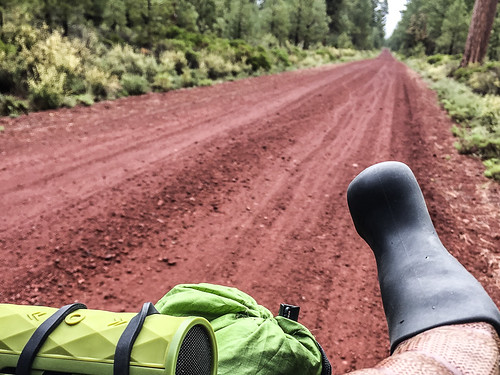
This do-it-all device was one of the pleasant surprises of my trip. On lonely and deserted backroads, the Buckshot’s speaker helped me keep my rhythm and sanity. When I flatted at 10:00 at night, the glowing lamp and flashlight functions made my repair work much easier. When I needed a little power boost for my phone, I just plugged it right in. All that functionality comes in a small, water and shock-resistant package that attached easily to my bike with the included rubber strap. This thing works great. It connects to my phone via Bluetooth and the battery has still never worn out on me. It’s also been fun to use while cruising around town on the weekends with my family. — Outdoor Tech
Sinewave Cycles Reactor ($220)
It was a huge relief to not worry about power or recharging my devices once this entire trip. One big reason for that is because I had a Reactor USB port by Sinewave Cycles in my stem cap that gave me reliable charging all day long (I also had an external battery and my Buckshot speaker which doubles as a power source). The guys at 21st Avenue Cycles hooked it up to my front dynamo hub and it worked as advertised. One caveat is that I had to be going over 12 mph or so for the charge to really get going. — Sinewave
I hope these gear recommendations are helpful. And thanks to all the companies that supported my trip. It would not have gone as smoothly without your help!
I’m happy to answer questions about them, and I’d love to hear your bikepacking product recommendations in the comments section.

